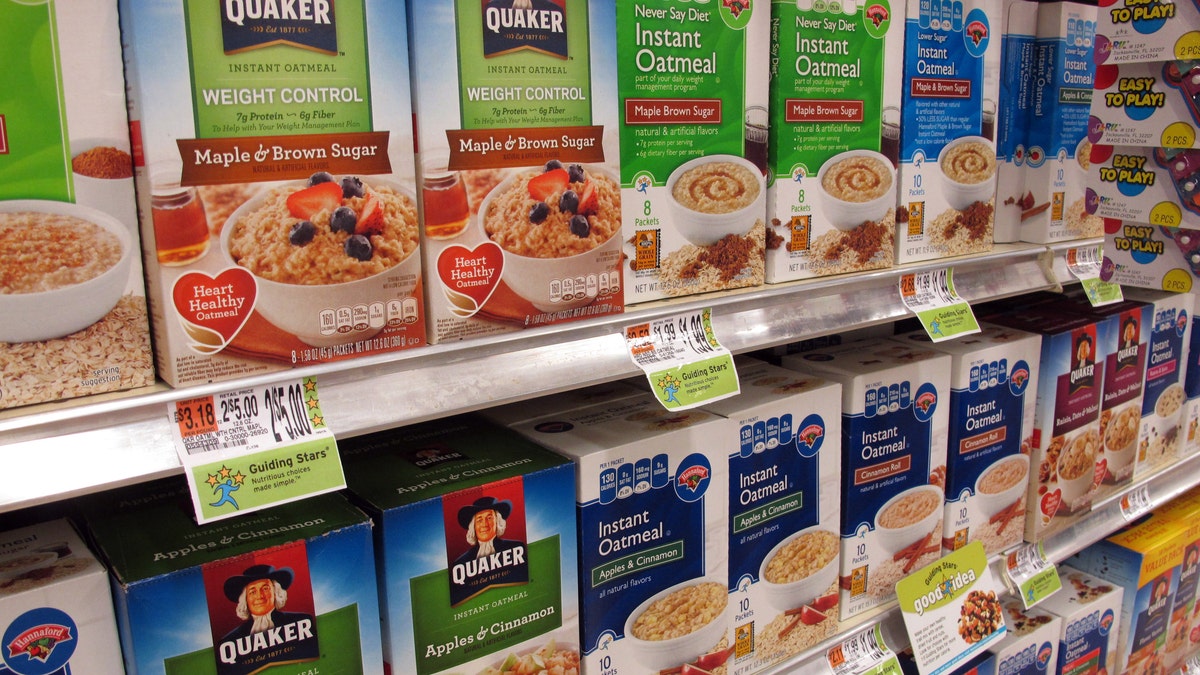
Hannaford stores feature the company's Guiding Stars rating system, as shown on price tags in the cereal aisle at a South Portland, Maine, store. (AP Photo/Clarke Canfield)
Reading food labels to make healthy, informed selections can often feel like navigating a landmine. For those looking to eat healthy foods and watching their weight, terms like, “Reduced Fat” or “Light” can be a gold mine. We decipher the top five “dieting” terms here:
Reduced fat:
Fat content has been reduced by 25 percent compared to the same regular product. This does not indicate that a product is low in fat, or in calories for that matter, but simply that there has been a reduction in fat compared to the full-fat product. For example, reduced fat milk still contains 5g of fat per cup and 130 calories compared to whole milk with 8g of fat and 150 calories. We recommend sticking with skim milk or 1 percent fat dairy products.
Light:
Used when a product has 50 percent less fat than the same regular product and/or the calories have been reduced by at least 1/3. For example, light feta cheese contains 40-45 calories and just 2-3g fat per serving compared to traditional feta, which has 70 calories and 6g fat. And be sure to read the food label on products labeled “light” to ensure the claim correlates to the ingredients and nutrition facts rather than color or flavor. Light olive oil and light brown sugar, for example, indicate less intense in flavor and a lighter color respectively, not lower in calories or fat.
Low-fat:
This indicates that a product has less than 3 grams of fat per serving. Again, even if a food is low in fat, the food may not necessarily be low in calories or nutritious. A low-fat food can be, and often is, high in sugar to replace the removed fat and improve the taste. A low-fat blueberry muffin, for example, does have less fat than a standard blueberry muffin but similar calorie content and more carbohydrates. Don’t set yourself up for a sugar crash! Opt for fresh blueberries in creamy non-fat Greek Yogurt or on top of high-fiber crackers instead.
Trans fat free:
If a product contains less than 0.5g of artery-clogging trans fat per serving it can claim to be “trans fat free,” but trace amounts may be present. If more than one serving is consumed, those seemingly miniscule amounts add up. Scan ingredient lists and avoid products that contain shortening or hydrogenated or partially hydrogenated oils, which include store-bought piecrusts and the deep-fried appetizer at your local restaurant.
Cholesterol free:
Cholesterol is naturally created by the liver, so plants do not produce cholesterol. Products labeled cholesterol-free imply no ingredient contains cholesterol, not that it is healthy or low in fat or calories, or sugar. So that package of gummies brightly labeled as cholesterol free? Still not a healthy option. We recommend sticking with bonafide cholesterol free foods like fresh vegetables and fruit that contain fiber, proven to lower unhealthy cholesterol levels.
Tanya Zuckerbrot MS, RD, is a Registered Dietitian in New York City and the author of two bestselling diet books: The F-Factor Diet and The Miracle Carb Diet: Make Calories and Fat Disappear – with Fiber.
Subscribe to Tanya’s FREE Weekly Newsletter and follow her on Instagram, Facebook, Twitter and Pinterest. To learn more about Tanya’s private nutrition counseling services visit www.ffactor.com
